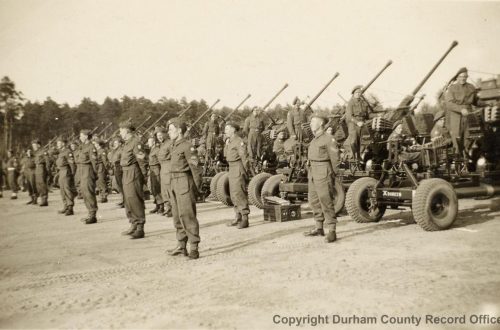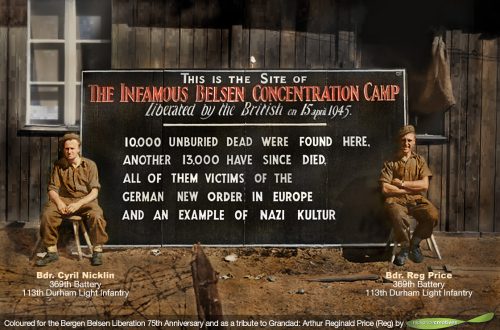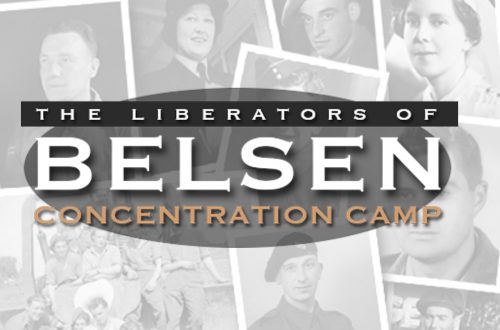Charles Hall 113th DLI
When Charles Hall was told his unit would be travelling behind enemy lines to take charge of a Nazi concentration camp, he could hardly have imagined the horrors he was about to encounter. Paul Willis, Northen Echo, meets a man who helped liberate Belsen.
DURING a lull in the conversation at Charles Hall’s Hartlepool home, the 86-year-old war veteran excuses himself for a few minutes. While he is out of the room, his wife Gladys turns to me. “Do you know,” she says. “We’ve been married for 16 years and it’s taken that long for this to come out.”
What has come out is Charles’s involvement in the liberation of the Nazi death camp at Bergen-Belsen, near Hanover in Germany. But it’s not surprising that he has kept the details of what he saw there secret for so long. For what greeted British troops as they entered the camp in April 1945 was a scene of abject horror.
The camp, which was liberated by the 63rd anti-tank regiment of the Royal Artillery 60 years ago this month, was the scene of an estimated 70,000 deaths, including that of the diarist Anne Frank.
As a testament to the inhumanity of the SS officers running it – an inhumanity which would later see 11 of them, including camp commandant Josef Cramer, executed for war crimes – bodies were left to rot outside prisoners’ huts or piled high in open graves.
Charles was in the 113th anti-aircraft regiment of the Royal Artillery, which arrived at the camp six days after it was first liberated.
“We covered 260 miles in 22 hours to get there, but we had no idea what to expect. The German generals had called a truce to take us in there because I think there was a fear that typhus, which was already affecting many of the prisoners, might spread out of the camp,” he says.
“As we got nearer you could smell the place a long time before it came into view. We had to be de-loused before we went in.
‘It was a total shock what we saw. I went up the main street of the camp. There were huts on either side and in front of the huts up the full length of the street on both sides was a low wall a few feet high. The wall was made up completely of bodies.”
This apocalyptic scene has become familiar to us over the years as generation after generation has been desensitised to the appalling cruelty of the Holocaust.
But because of the smokescreen of war and a lack of concern over the fate of the Jews among the Allied leadership, the average British Tommy in 1945 knew nothing about the Nazi’s Final Solution.
Charles says: “All we knew was that we were going to a camp containing prisoners of war, nothing more.”
Most of the 60,000 surviving inmates were in a critical condition and the British were totally unprepared to deal with the situation. Typhus was rife and during the first five days of the liberation 14,000 inmates died. In the coming weeks that figure doubled.
Over the next month, Charles and his regiment worked to help set up a hospital in the camp to treat the starved and diseased-ridden survivors.
“I had nothing but admiration for the medical staff,” he says. “They worked tirelessly to treat people. They also managed to contain the spread of disease into the surrounding area, which was a real fear at the time.”
Even though the Germans had ceded control of Belsen to the British they continued to maintain a presence there. This meant that after nearly six years of fighting against the Germans, Charles was put in the paradoxical position of working alongside the enemy, even sharing guard duty with German soldiers.
They also supervised as German soldiers carried out the grim task of clearing the bodies.
“It turned your stomach to see that. There were four huge pits that had been dug, each containing two to three thousand bodies. The bodies were of men and women, old and young.
“We were billeted outside the camp and had to go in there every day. You sort of felt you didn’t want to be in there because of the state it was in. But at the same time you were grateful that you could do something to help the survivors,” he says.
Belsen was officially established by the Nazis in April 1943 and was intended as an “exchange camp”, where prisoners would be swapped with German nationals being held in Allied countries. Jewish prisoners from other concentration camps were drafted in to build the camp.
In reality, only a few of the Jews who were brought to Belsen were ever set free and after thousands of survivors of the Nazi death marches reached the camp at the end of 1944, living conditions there deteriorated rapidly.
The administration did not even try to house them and a raging typhus epidemic broke out. From January 1945 until its eventual liberation four months later, 35,000 prisoners perished.
Charles was just 26 when his regiment arrived at the gates of the camp. He had joined the Territorial Army as an enthusiastic teenager in 1938 and was involved in the war effort from the start.
His Army career had seen him take part in the Normandy landings and he had seen many of the horrors of war. Nevertheless, he concedes that the grim scenes he witnessed at Belsen were the most disturbing of his war experience.
“When I came home I didn’t want to talk about it – I tried to put it out of my mind. I suffered with nightmares for a while,” he says.
Despite this, Charles has kept a souvenir from the camp, which was eventually burnt to the ground by the British on May 21, 1945. He shows me a thick, white porcelain plate dated 1936 and emblazoned on the back with the eagle crest of the Third Reich. It looks too expensively made to have been given to the prisoners and was probably for the SS officers.
He says: “I found this in the camp. I used it for the rest of the war and even when I came home. I’m not really sure why I kept it. I suppose I just wanted a better plate to eat on, things were hard to come by in those days.”
Gladys winces. She says: “I won’t let him use it now, not after I found out where it had come from.”
Charles’s only other memento is an official booklet produced by the British Army which was given to all the soldiers who had helped in the camp’s liberation.
The booklet contains photographs taken at the camp, including one showing a visit by the burgermeisters – mayors of local towns. The burgermeisters are shown standing around the edge of one of the mass graves.
Charles says: “They said they knew nothing about what had been going on there. I don’t know whether that was true. All I know is that I didn’t have much time for Germans when I first came back home.”
Archive: The Northern Echo, 23rd April, 2005.
8,022 total views



